Ohio has extremely diverse habitats and landscapes. The state is home to many different species, including a fascinating array of owls. There are 12 owl species that live in Ohio during at least part of the year. According to eBird data, only eight of these species spend the entire year in the state. The other four are not permanent residents, migrating through the state sporadically throughout the year.
In this article, we will dive deep into the 12 owl species you can find in Ohio. Let’s get straight to it!
Rare Owls in Ohio
Here are a few of the rare owl species in Ohio.
1. Northern Hawk Owl (Surnia ulula)
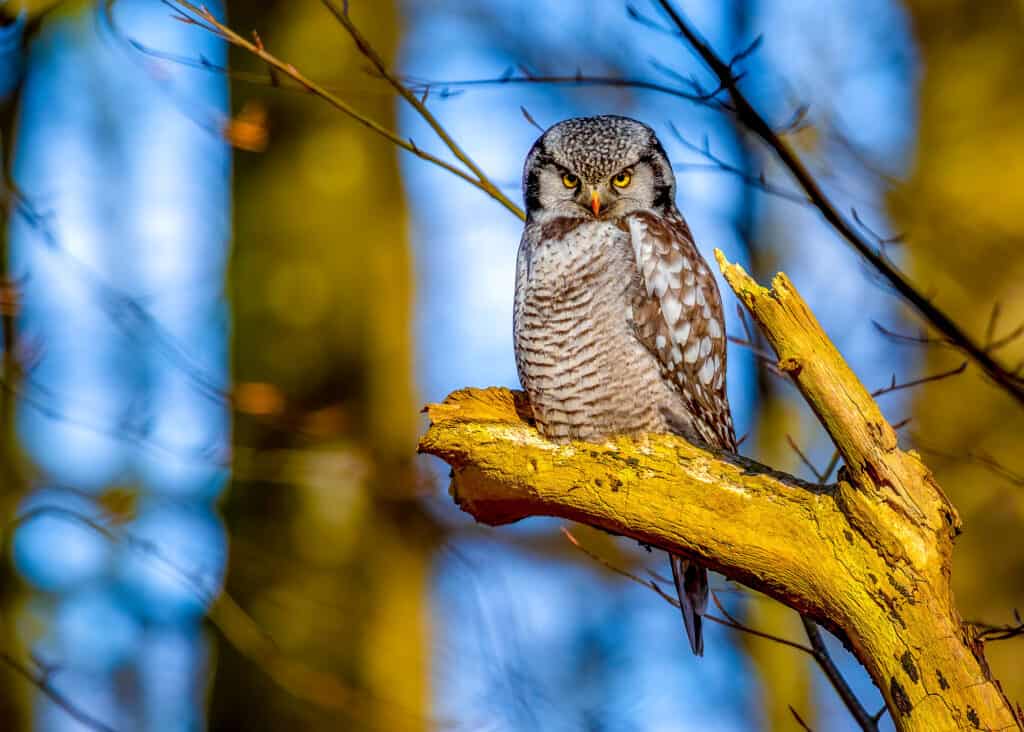
This owl species resembles both an owl and a hawk.
©Svitlana Tkach/Shutterstock.com
The northern hawk owl is an extremely rare species in Ohio. The bird exhibits a blend of raptor and owl traits. This medium-sized daytime owl stands at about 14 to 17 inches tall, with a wingspan of nearly 2.5 to 3 feet across. It has a unique squared-off head, a long tail, and a mix of black and white colors.
You can usually spot this owl near marshes or pine forests. The northern hawk owl has an intriguing flying style; it beats its wings fast and glides just above the ground, almost like a hawk. Its powerful eyes can spot a tiny mammal from half a mile away. When this owl spots prey, it dives down super fast and grabs its meal with its talons.
While northern hawk owls usually live far north in places like Alaska and Canada, they have been spotted in the continental US. When the winter is particularly cold, and food is scarce, they may venture into Ohio. So, if you are in Ohio during a cold winter, keep your eyes peeled for this magnificent owl!
2. Boreal Owl (Aegolius funereus)

The boreal owl is very rare in Ohio.
©WildMedia/Shutterstock.com
Another rare owl species in Ohio is the boreal owl. This is a relatively small species that is mostly found in places like Canada, Alaska, and the mountainous regions of the northern USA. That said, some may venture further into the mainland USA. This owl is small, roughly 8 to 11 inches tall, with wings that stretch about 21 to 24 inches wide. Additionally, it only weighs 3.3 to 7.6 ounces! The boreal owl has a wide, round head that’s dark brown with white speckles.
You’ll have to get super lucky to spot this owl in Ohio, as they’re pretty rare. They love cold, dense forests and often set up homes in old holes made by woodpeckers. When it comes to hunting at night, they patiently wait and watch for prey, moving quickly through the air to grab a meal when they see a small rodent. Female boreal owls are typically a bit larger than the males. Think you might have heard this bird? Its call sounds like a fast series of quick hoots echoing through the woods.
3. Burrowing Owl (Athene cunicularia)

Despite its name, this owl species typically lives in holes in the ground that other animals, like groundhogs, make.
©iStock.com/LagunaticPhoto
The burrowing owl is a unique owl species because it is diurnal. Only a few owl species are daytime-active, so the burrowing owl breaks the typical stereotype. They measure around 7 to 11 inches tall and have an impressive wingspan of up to 2 feet!
Looking for this owl in the wild? Keep an eye out for its round head without those usual pointy ear tufts, long slender legs, and striking yellow eyes. Covering its body are brown feathers with white spots.
These owls are most commonly spotted west of the Mississippi River, but occasionally, they make a surprise appearance in Ohio. Unlike other owls, they have an interesting living arrangement: they nest in burrows, residing primarily in grasslands, deserts, and other open vistas. Sometimes, they’ll even use old homes left by prairie dogs.
When it comes to their diet, they’re pretty flexible. They will typically eat a variety of rodents, reptiles, insects, and even fish! Like most other owl species, burrowing owls are monogamous, forming pairs for life!
4. Great Gray Owl (Strix nebulosa)
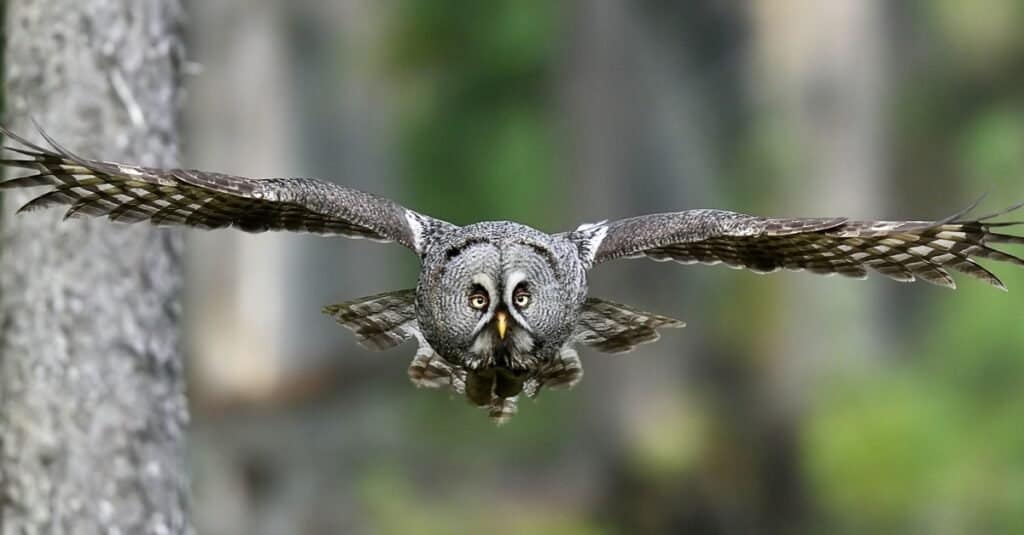
The largest owl species in North America, great grey owls are magnificent birds.
©Erik Mandre/Shutterstock.com
The great gray owl is a large owl species that is rarely spotted in Ohio. This is a truly massive owl with a height of up to 27 inches and a weight of up to 3.75 pounds! In fact, the great grey owl is the largest owl species in North America, with wings that stretch up to 4 feet! They mostly live in Alaska, northern Canada, and the Rocky Mountains. But, they also occasionally migrate south to the Great Lakes during winter. Bird watchers have reported great grey owls on a few occasions in Ohio.
This owl is a true beauty. Its round head and dark gray feathers stand out, especially with the lighter patterns sprinkled over its body. Additionally, around its face, there’s this neat black border, which highlights two white spots right on its throat. This owl has a recognizable call. If you ever hear a resounding “woot…hoo” sound in the woods, it is probably this grand bird.
These birds are expert hunters, waiting patiently in the treetops, then swiftly swooping down and catching small mammals like voles, squirrels, mice, and even small birds. Their bright yellow eyes might not often be seen in Ohio, but when they are, it’s a true gift to the state’s natural beauty.
5. Snowy Owl (Bubo scandiacus)

Breeding in the far north reaches of the Arctic, snowy owls venture south outside of mating season.
©Carol Gray/iStock via Getty Images
The snowy owl is a real standout in Ohio’s collection of birds. These amazing birds are almost completely white. Snowy owls are not the largest owl species, but as they nest in the frozen Arctic, they require a TON of feathers. This makes them heavier than the average owl. They weigh between 3.5 to 6 pounds and have a wingspan spanning 4 to 5 feet. Snowy owls have shining yellow eyes and a rounded head without the typical pointy ear tufts. You can often see these owls near Lake Erie in Ohio, especially in the middle of winter. Snowy owls are relatively rare in Ohio, so seeing one in the wild is a real treat!
These owls originally come from way up north in the Arctic tundra, which is their nesting ground. They breed and nest in the Arctic Circle during the spring and summer and then head south in fall and winter.
Interestingly, snowy owls barely make any sound outside of breeding season. So, unless you are in the Arctic Circle, it is unlikely that you will hear one. Like other owls, snowy owls are carnivorous, eating small rodents and other animals.
Common Owls in Ohio
Now, let’s take a look at some of Ohio’s more common owl residents.
6. Eastern Screech Owl (Megascops asio)
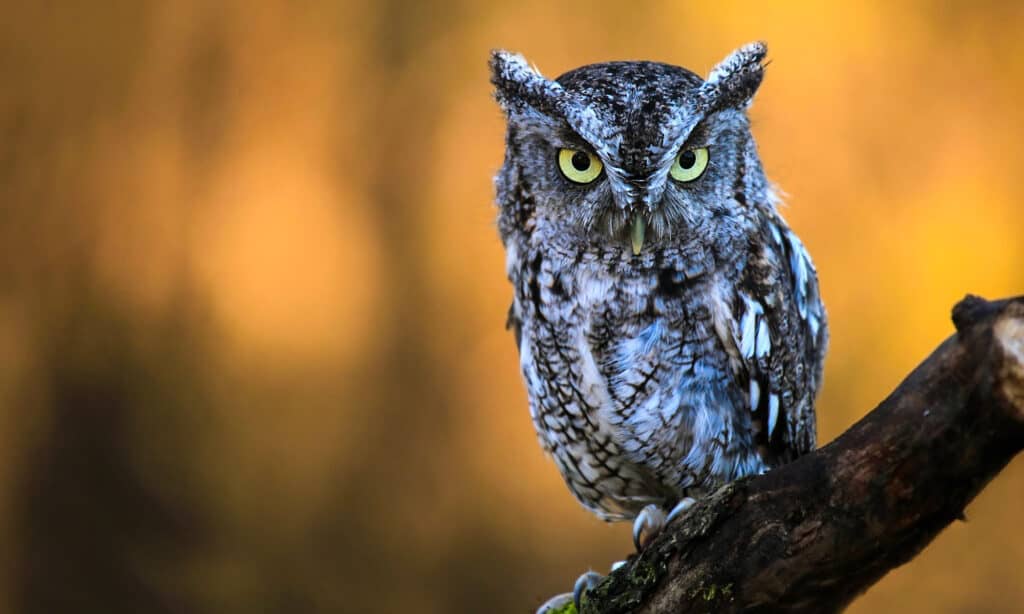
This is the most common owl species in Ohio.
©mlorenz/Shutterstock.com
The eastern screech owl is one of the most common owl species in Ohio. This small bird is around 6 to 10 inches tall and reaches a maximum of 8 ounces. These owls are experts at blending into trees, wearing nature’s own camouflage. Surprisingly, you can spot eastern screech owls near many bustling towns and cities.
What’s cool about them? Well, they have false fluffy “ear” tufts, which make them look tough and help attract mates. In nature, you can find these owls living near forests or bodies of water, but they will nest in your backyard if you install a nesting box. These tiny owls eat insects, little rodents, and even songbirds. Generally, the male owl hunts and brings food back for the family.
If you are out at night in Ohio and hear an owl call, chances are it is an eastern screech owl.
7. Great Horned Owl (Bubo virginianus)
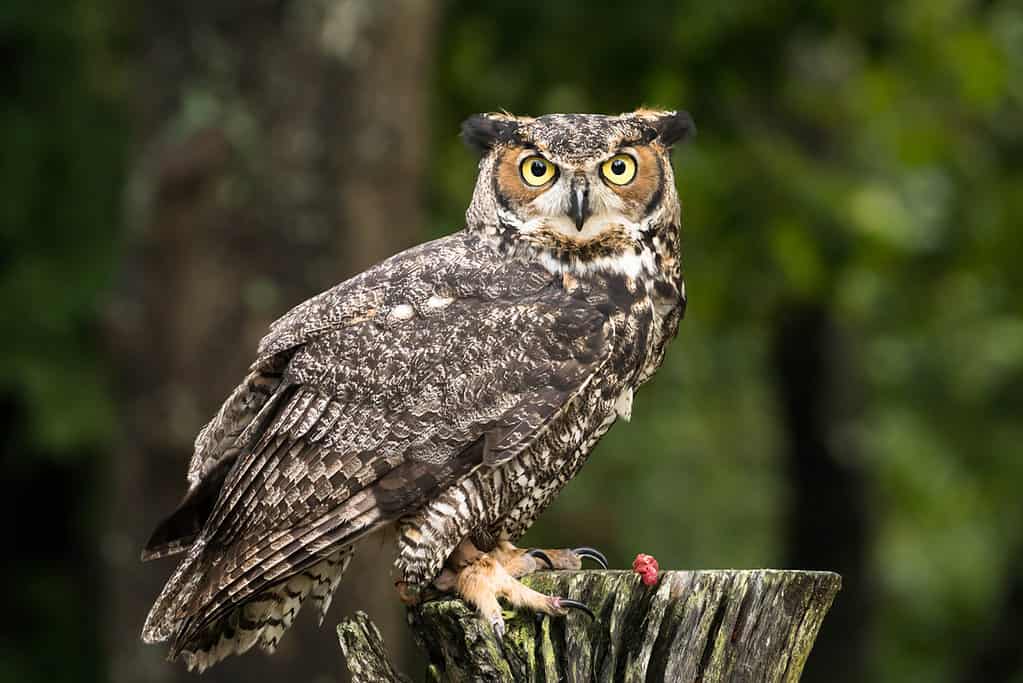
The tufts on a great horned owl’s head are neither horns nor ears but simply ornamental feathers.
©iStock.com/makasana
The great horned owl is a seriously impressive bird, weighing up to nearly 4 pounds. This is one of the most common owl species in North America, including Ohio. The most significant identifying feature of the great horned owl is, of course, the horn-like tufts on its head. Its feathers come in a mix of colors, such as gray, brown, black, and white feathers. helping it hide perfectly at night.
So, what does it eat? Basically, any small animals it can find, including mice, birds, and other small creatures. In Ohio, it’s revered as one of the largest owl species. At night, you might sometimes hear the great horned owl in a musical duet with a nearby mate.
Instead of building its own nests, it just takes over old ones or uses tree hollows. This owl doesn’t travel much and likes to keep to itself. If you ever see one in Ohio, consider it a real treat! These are magnificent birds/
8. Barred Owl (Strix varia)

Skilled hunters with a wingspan of up to 4 feet, barred owls are amazing birds of prey.
©Jim Cumming/Shutterstock.com
The barred owl is a common sight in Ohio. This medium-sized bird stands about 16 to 25 inches in length and weighs less than 2 pounds. Its wings are pretty wide, nearly 4 feet!
These birds have a unique call that vaguely sounds like it is saying, “Who cooks for you?” These owls are monogamous, mating for life and raising a single clutch of eggs per year.
The best place to spot barred owls is in forested areas of Northern Ohio. You can identify these birds by their distinctive horizontal stripes of dark and pale brown, heart-shaped facial disk, reddish-brown body markings, and pitch-black eyes.
Unlike some other owl species, barred owls don’t have “horn” feathers on their heads. For the best chance to spot one of these birds, you’ll need to take a night stroll, as they are nocturnal.
9. Northern Saw-Whet Owl (Aegolius acadicus)
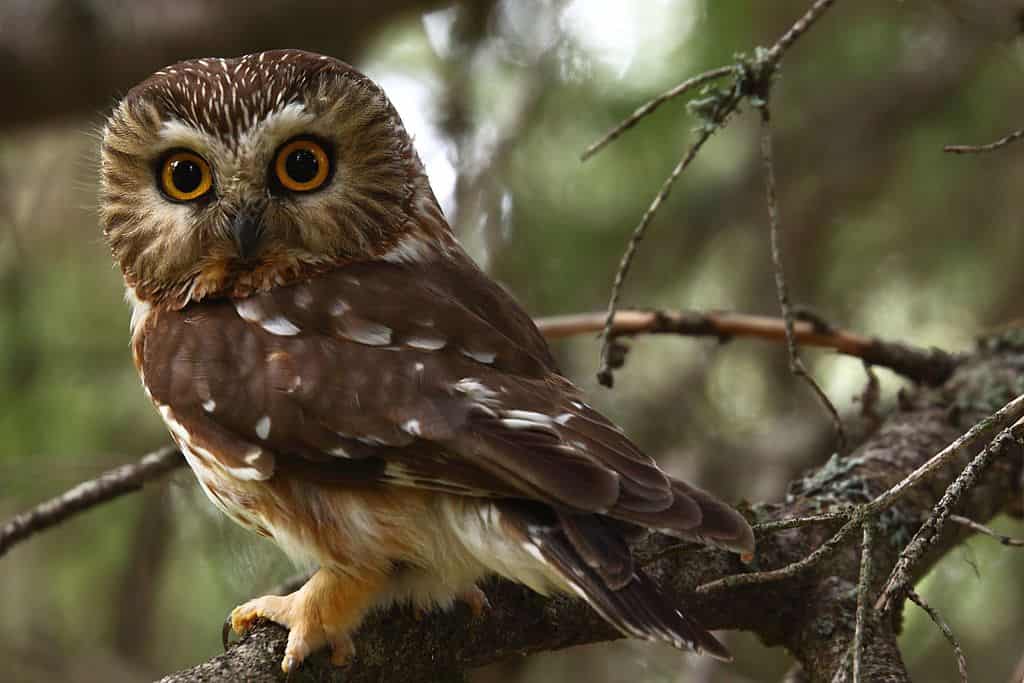
This is one of the smallest owls in the world and the tiniest bird of prey in North America.
©Kameron Perensovich, CC BY-SA 2.0, via Wikimedia Commons – Original / License
The northern saw-whet owl — which calls several parts of Ohio home — is a teeny tiny species. In fact, this is the smallest owl species in North America! This owl is just 7 to 9 inches in length, with a weight of 2.2 to 5.4 ounces. It has a wingspan of less than 22 inches. Despite its size, it’s still an impressive hunter.
Its name comes from its call that strangely sounds like someone sharpening a saw. You can generally hear it in Ohio’s quiet forests, especially near water. In terms of color, the northern saw-whet owl is a mix of brown and white with cool black spots, which allows it to hide seamlessly among the trees. This little predator mainly eats small mice, but it will also munch on bugs and even small birds. Interestingly, while it lives across North America, many of its habits, especially its moving patterns in Ohio’s green forests, remain a mystery.
10. Barn Owl (Tyto alba)
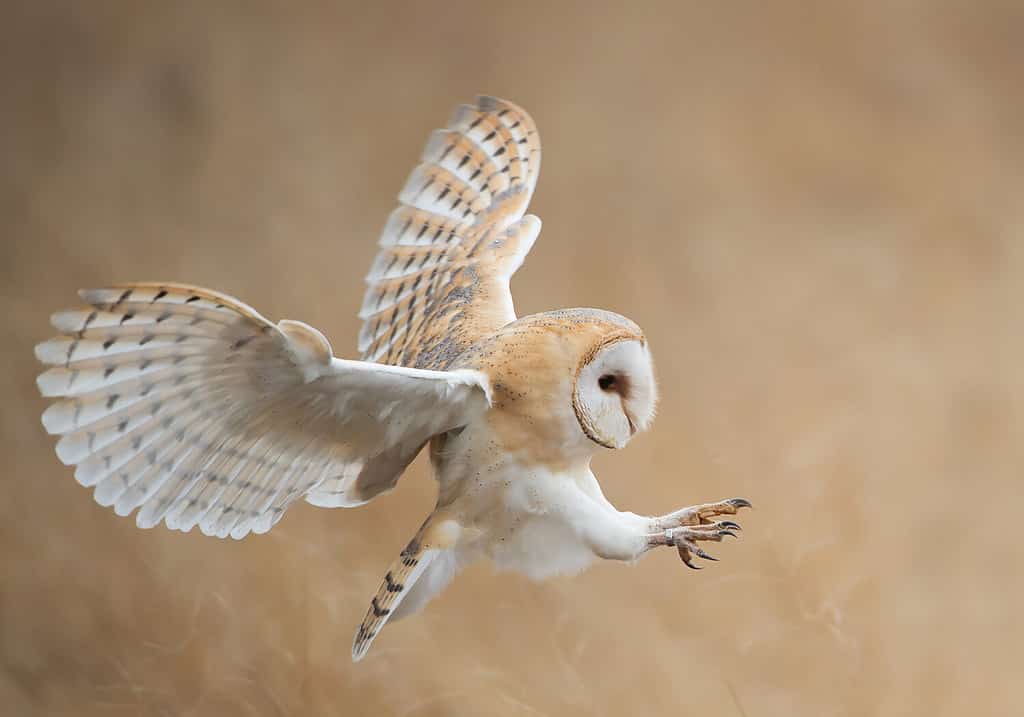
One of the most recognizable owl species is the barn owl.
©MZPHOTO.CZ/Shutterstock.com
The barn owl is an amazing medium-sized bird of prey. It has a recognizable face that strangely resembles a monkey’s nose. It is also known by various nicknames like “ghost owl,” “church owl,” or “monkey-faced owl.” This owl, impressively, can spread its wings from 3 to 4 feet, and it’s about 14 to 20 inches in height. Female barn owls are generally a bit larger than the males and tend to have more spots of color on their chest.
As their name suggests, barn owls commonly set up their home in human establishments. They may nest in old barns, tree holes, or even church towers. These birds are like night-time ninjas. They can hunt in total darkness using their amazing ears, which help them hear low-pitch sounds. So, if you ever hear a long, echoing “shriiiiii!” late at night, you’re probably close to a barn owl on the prowl. They feed on rats and other small rodents, making them nature’s own pest control.
11. Long-Eared Owl (Asio otus)
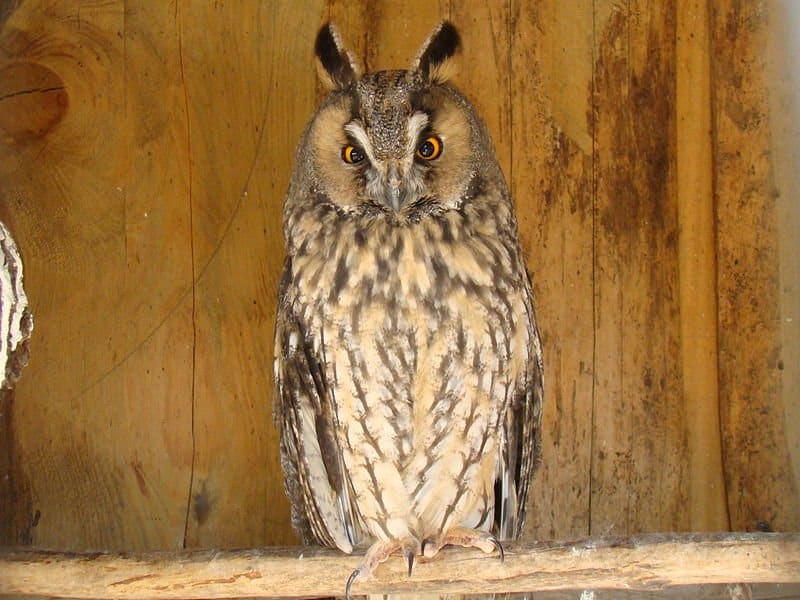
This owl, the long-eared owl, has extremely recognizable ear tufts.
©Mindaugas Urbonas / Creative Commons – Original
The long-eared owl is a medium-sized owl that can be spotted in Ohio’s woods, especially in winter and in the northeast part of the state. It’s a pretty small species weighing less than a pound and standing just over a foot tall with a wingspan of 3 feet.
What makes this owl stand out? It’s got cool long tufts on its head that look like ears, though they are not actually its ears. Long-eared owls have large, yellow eyes, set wide apart beneath a white “X” mark.
These owls have excellent camouflage and can hide extremely well when searching for prey. If you are out at night, you may hear this bird’s loud call. They have a penetrating “hoot” that can be heard from very far away. Long-eared owls, like all owl species are expert hunters, super quiet and efficient.
Additionally, after eating, they regurgitate the animal parts they can’t digest as a pellet. It is most common to see these owls in Northeastern Ohio during the entire year, in some months you might spot them in other parts of the state, too. One of the most common owl species in Ohio, the long-eared owl is a crucial part of the ecosystem.
12. Short-Eared Owl (Asio flammeus)
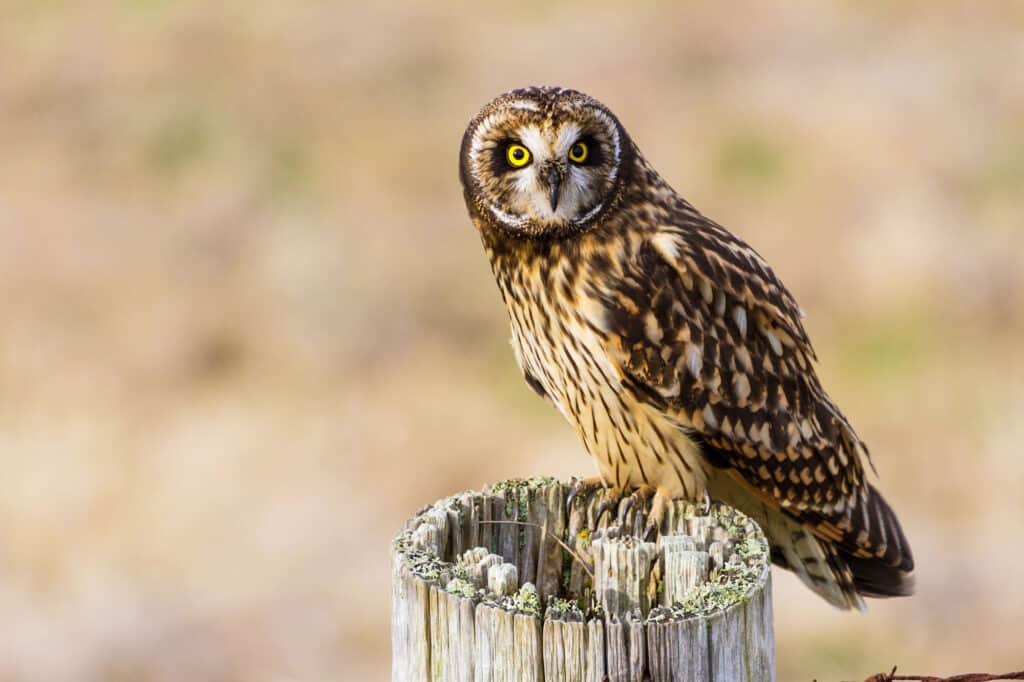
Short-eared owls are a common sight in northwest Ohio.
©iStock.com/Devonyu
Another common species in Ohio is the short-eared owl. This species is relatively small with a wingspan of 2.7 to 3.5 feet, and weighing between half a pound to a pound. It has a distinct look that sets it apart in Ohio. Like the long-eared owl, short-eared owls have ear tufts, though they are much smaller. Their ear tufts appear like tiny horns on the top of the bird’s head. The face of a short-eared owl is light, and their bright yellow eyes have a dark ring around them. Their back has a beautiful mix of brown, white, and beige colors.
You’d mostly find these owls in the northwestern parts of Ohio, near the border with Michigan. That said, they do tend to roam the state, especially between late November and mid-March.
These owls have an extremely big range. You can find them breeding as far north as Alaska and Northern Canada and as South as Michigan. Outside of breeding season, short-eared owls will fly as far south as central Mexico! Ohio’s Lake Erie region attracts many of these birds (as well as other species) making it a hotspot for birdwatchers. So, if you’re in Ohio during winter and spot a short-eared owl, count yourself lucky!
Where and When to See Owls in Ohio
If you’re an owl enthusiast in Ohio, you’re in luck as the state boasts twelve owl species, eight of which are regular residents and four are rare visitors. The best places and times to spot these magnificent birds include:
- Woodlands and Forests: For year-round residents like the barred owl, great horned owl, eastern screech-owl, and northern saw-whet owl, Ohio’s deciduous, coniferous, and mixed hardwood forests are prime locations. Early evening and dawn are typically the best times to listen to their distinctive calls.
- Open Fields: Keep an eye out in open fields, especially during the day, for the short-eared owl, which can be found in such habitats. In winter, these fields also welcome the snowy owl, though sightings are rare.
- Urban and Open Habitats: Barn owls frequent many urban areas and are quite common in Ohio. Open habitats with mild or no winters are their preferred locales.
- Grasslands: The rare burrowing owl can be seen in grasslands and other wide-open habitats, they are active during the day and sleep at night.
When to See Owls in Ohio?
There are 8 owl species that are permanent residents of the state. The best time of year to spot owls in the state remains winter. This is when the 4 non-resident species migrate to the state and it is the breeding season for most species.
For the best owl-spotting experience, equip yourself with a good pair of binoculars and familiarize yourself with their calls. Early mornings or late evenings are ideal as many owl species are most active during these times. Remember, patience is key; while you might not always spot them, listening to their hoots and calls can be equally rewarding.
Summary of the Types of Owls in Ohio (From Rarest to Most Common)
| Number | Owl | Scientific Name | Rarity in Ohio |
|---|---|---|---|
| 1. | Northern Hawk Owl | Athene cunicularia | Rare |
| 2. | Boreal Owl | Surnia ulula | Rare |
| 3. | Burrowing Owl | Aegolius funereus | Rare |
| 4. | Great Gray Owl | Strix nebulosa | Rare |
| 5. | Snowy Owl | Bubo scandiacus | Rare |
| 6. | Eastern Screech-Owl | Strix varia | Common |
| 7. | Great Horned Owl | Bubo virginianus | Common |
| 8. | Barred Owl | Megascops asio | Common |
| 9. | Northern Saw-Whet Owl | Asio flammeus | Common |
| 10. | Barn Owl | Aegolius acadicus | Common |
| 11. | Long-Eared Owl | Tyto alba | Common |
| 12. | Short-Eared Owl | Asio otus | Common |
The photo featured at the top of this post is © Carol Gray/iStock via Getty Images
Thank you for reading! Have some feedback for us? Contact the AZ Animals editorial team.







